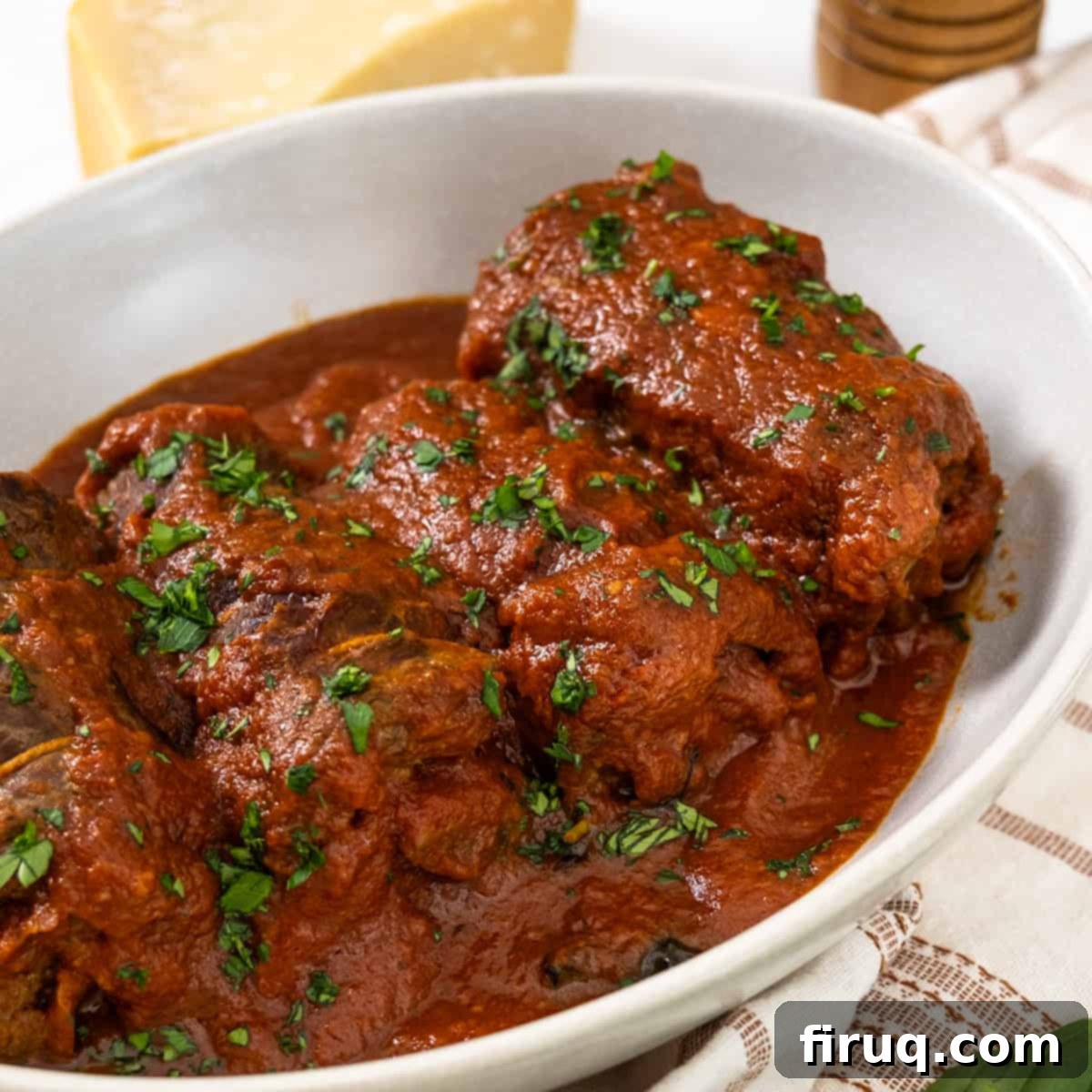Authentic Italian Braciole Recipe: A Sunday Sauce Classic
Elevate your Sunday Sauce with the ultimate meaty addition: this incredible authentic Italian Braciole. Forget your usual meatballs and sausages for a moment and prepare to indulge in tender, slow-braised beef rolls, generously filled with savory prosciutto, aromatic breadcrumbs, and rich Parmesan cheese. This traditional dish isn’t just a meal; it’s a celebration of Italian-American culinary heritage, promising a depth of flavor and a melt-in-your-mouth texture that will make it a new favorite in your kitchen.
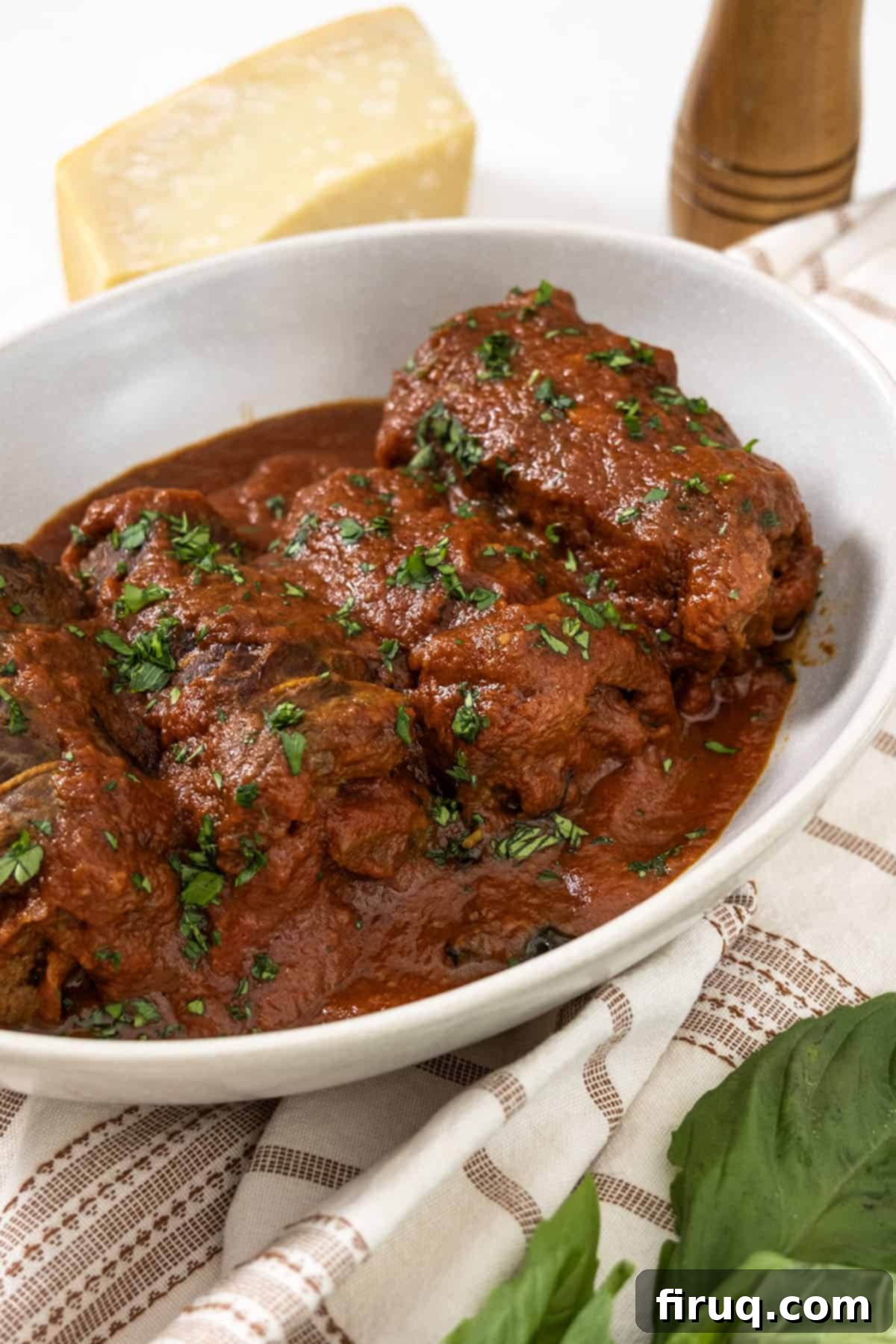
If you love the rich flavors of a classic Italian Sunday meal, then you also need to try our Italian Fried Meatballs or ring sausage! These succulent meats are perfect complements to fill your Sunday sauce with authentic meaty goodness.
[Advanced Jump To Menu Placeholder]
Why This Authentic Braciole Recipe?
Braciole, often mistakenly spelled as “bracciole”, is a cherished **Italian-American stuffed meat dish** that brings rich flavor and tender texture to any meal. This culinary gem involves thinly sliced beef (or other meats), which is then filled with a savory mixture of breadcrumbs, fresh herbs, Parmesan cheese, and delectable prosciutto. After being rolled and secured, these flavorful bundles are seared to lock in their juices and then slowly braised in a rich, homemade tomato sauce.
At its heart, braciole is a type of involtini, a broad Italian term for small, stuffed rolls of meat or vegetables. While the concept of stuffed meat rolls is common across Italy, the specific preparation of braciole can vary widely. In Southern Italy, particularly in regions like Calabria and Puglia, it’s often made with different cuts of beef or even pork and lamb, and the stuffing can range from simple herbs to more complex combinations of cheese and cured meats. In Italian-American households, especially those with roots in Southern Italy, this dish has evolved into the beloved Sunday Sauce staple we know today, often utilizing flank steak for its ideal texture when slow-cooked.
What makes *this* braciole recipe stand out is its commitment to both authentic flavor and an incredibly tender result. We’ll guide you through selecting the right meat, crafting the perfect savory filling, and achieving that signature melt-in-your-mouth tenderness through a long, gentle braise. It’s a dish that, while requiring a bit of time, rewards you with an unparalleled culinary experience, transforming humble ingredients into something truly extraordinary.
Ingredient Notes and Substitutions for Perfect Braciole
Crafting the perfect braciole starts with understanding your ingredients. Each component plays a vital role in achieving that sought-after authentic flavor and tender texture.
Steak Selection for Braciole: My top choice for beef braciole is undoubtedly flank steak. This cut, though lean, is incredibly responsive to slow braising, yielding an exceptionally tender result that practically falls apart with a fork. Its wide, flat shape also makes it ideal for rolling. You can prepare one large, impressive roll or, as I prefer, slice it into thinner sections to create several smaller, individual braciole rolls. This allows for more surface area to caramelize during searing and a more manageable serving size.
If flank steak isn’t available or you’d like to experiment, other excellent beef options include top-round steak or sirloin. When using a top round roast, ensure you slice it very thinly against the grain. Don’t hesitate to ask your butcher to thinly slice the meat for you; they often have the expertise and equipment for perfect, even cuts. For those seeking alternatives, braciole, or involtini more generally, can also be made with thinly sliced veal or pork cutlets. These lighter meats require a shorter cooking time, so adjust your braising period accordingly.
Quality Tomatoes for Your Sunday Sauce: The sauce is the heart of your braciole, and superior tomatoes are non-negotiable for a truly authentic flavor. I always use either high-quality crushed tomatoes or whole plum tomatoes, which I then blend myself to control the texture. For extended braising, investing in excellent tomatoes like San Marzano tomatoes is crucial. These Italian treasures are renowned for their balanced sweetness, low acidity, and rich, vibrant flavor. Unlike many generic or jarred sauces, San Marzano tomatoes won’t introduce unwanted acidity or artificial flavors, allowing the natural sweetness of the tomato to shine and complement the savory braciole beautifully.
The Savory Filling: The stuffing is what defines braciole’s interior flavor.
- Prosciutto: This thinly sliced, salty cured ham adds a delicate, savory layer and a wonderful umami depth that permeates the meat as it braises.
- Breadcrumbs: Acting as a binder and a texture enhancer, breadcrumbs absorb the delicious meat juices and sauce, keeping the filling moist. For the best flavor, use good quality plain breadcrumbs, or even homemade ones.
- Parmesan Cheese: Freshly grated Parmesan offers a sharp, salty, and nutty counterpoint to the richness of the meat and prosciutto. It melts beautifully into the filling, adding another layer of complex flavor.
- Herbs & Spices: Fresh parsley adds a burst of freshness, while garlic powder (or fresh minced garlic for a stronger punch) and salt are essential for seasoning the filling. Feel free to experiment with a pinch of dried oregano or red pepper flakes for an extra kick.
Red Wine: A splash of dry red wine (like Chianti or Merlot) in the sauce is not just for flavor; it helps deglaze the pot after searing the meat, lifting all those delicious browned bits (fond) from the bottom. This adds incredible depth and complexity to the tomato sauce.
Step-by-Step Directions for Authentic Italian Braciole
Follow these detailed steps to create tender, flavorful Italian braciole that will impress everyone at your table. With thinly sliced flank steak and a savory filling, each bite will be exquisite.
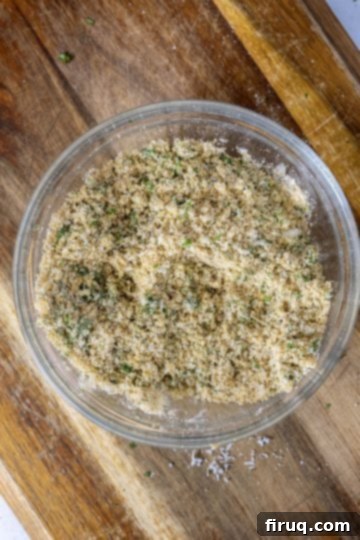
Step 1: Prepare the Braciole Filling. In a medium bowl, combine the breadcrumbs, finely chopped fresh parsley, grated Parmesan cheese, salt, and garlic powder. Drizzle in the olive oil and mix thoroughly until well combined. The mixture should have a clumpy but not wet texture – it should almost stick together when pressed but still crumble easily. The exact amount of olive oil may vary depending on the type and brand of breadcrumbs you use, so add a little more if needed to achieve the desired consistency. This flavorful mixture will form the heart of your braciole.
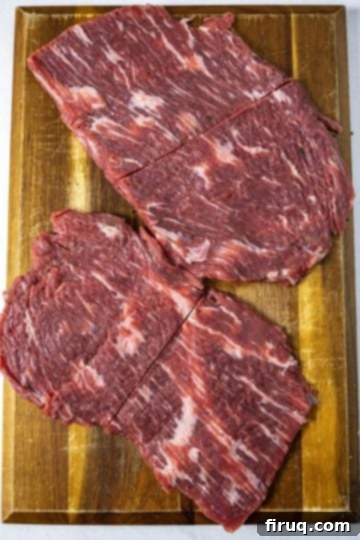
Step 2: Tenderize the Flank Steak. Carefully thinly slice the flank steak with a very sharp knife into 2 or 3 even pieces, depending on its original thickness. Aim for pieces roughly ⅛ to ¼ inch thick. Lay each steak slice flat on a cutting board, cover with plastic wrap, and use a meat tenderizer or the flat side of a mallet to beat the meat until it’s evenly flattened and tender. This step is crucial for ensuring the braciole cooks evenly and achieves its signature tenderness. Season both sides lightly with salt and pepper.
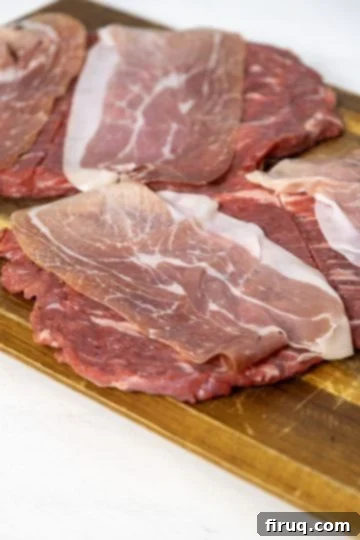
Step 3: Layer the Prosciutto. Lay the prosciutto slices flat over each tenderized steak piece. Ensure the prosciutto covers most of the meat, leaving a small border around the edges. This adds a fantastic salty, umami flavor that melts into the beef during cooking, creating an irresistible aroma and taste.
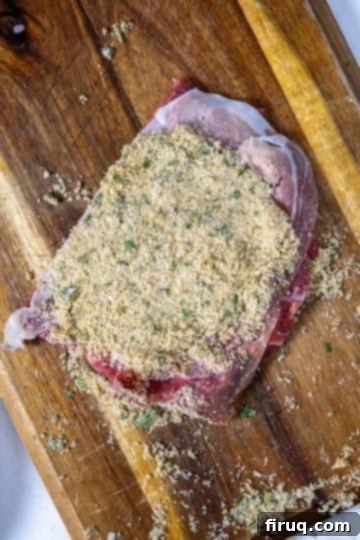
Step 4: Add the Breadcrumb Mixture. Generously spread the prepared breadcrumb mixture over the prosciutto layer on each flank steak piece. Don’t worry if a little bit of the filling spills out when you start rolling; it’s completely normal and can easily be scooped up and added to subsequent rolls. The key is to distribute the filling evenly to ensure every bite of braciole is packed with flavor.
Step 5: Roll and Secure the Braciole. Carefully roll each steak piece tightly, starting from one end. Once rolled, secure each braciole with butcher’s string at several points along its length. This is crucial to keep the filling locked inside during searing and braising. Season the outside of the rolled braciole with a final sprinkle of salt and freshly ground black pepper.
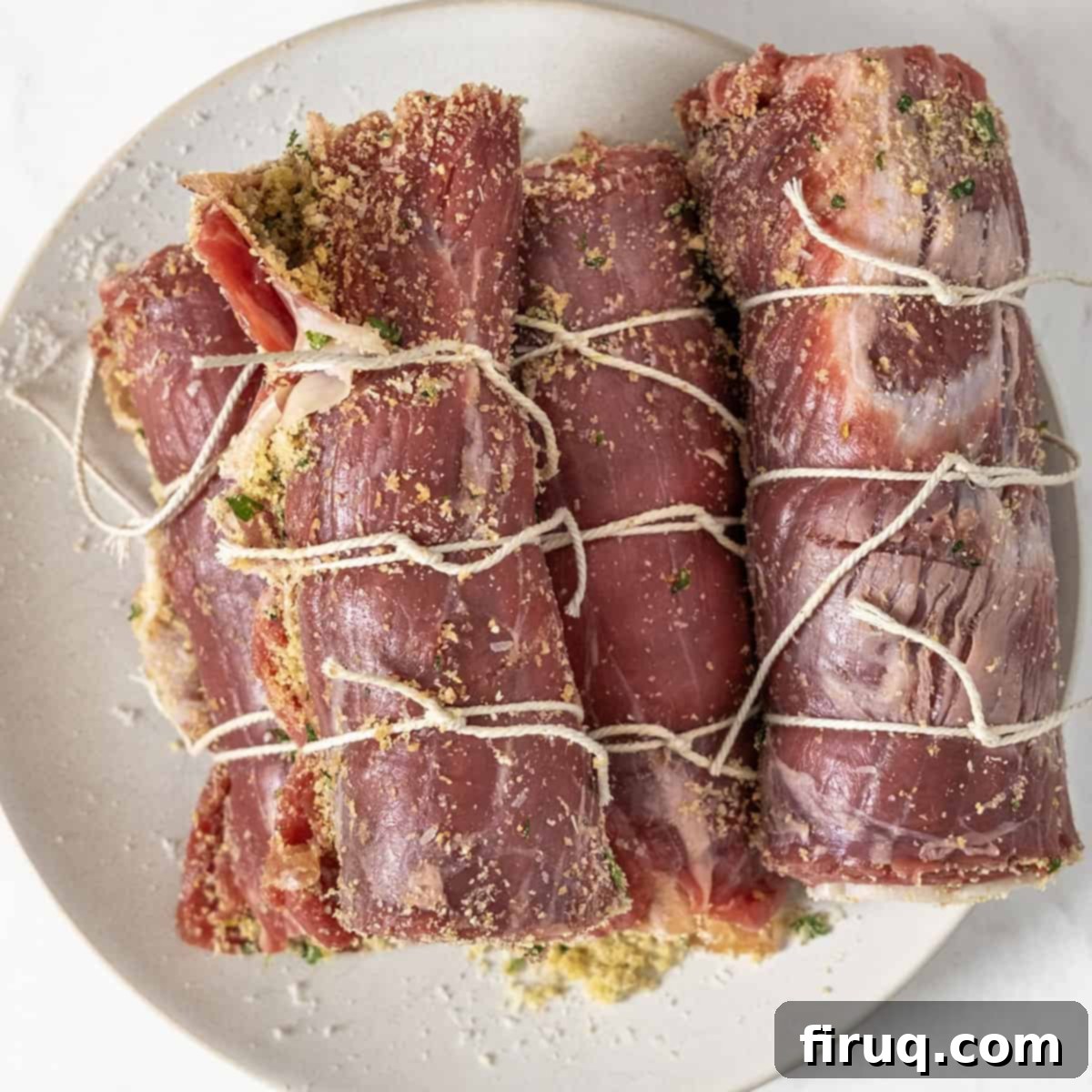
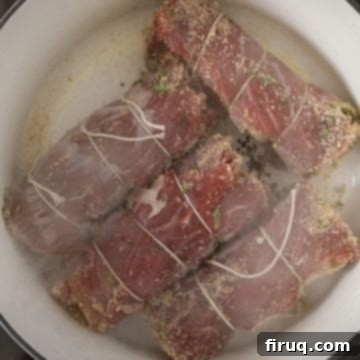
Step 6: Sear the Braciole. In a large, heavy-bottomed pot or Dutch oven, add 1 tablespoon of olive oil and heat over medium-high heat until it is very hot, just before it begins to smoke. Carefully place the prepared braciole rolls into the hot pot to sear. This crucial step creates a beautiful brown crust, locking in moisture and developing deep, complex flavors through the Maillard reaction. Be sure to sear in batches if necessary, to avoid overcrowding the pan and lowering the temperature, which would steam the meat instead of searing it.
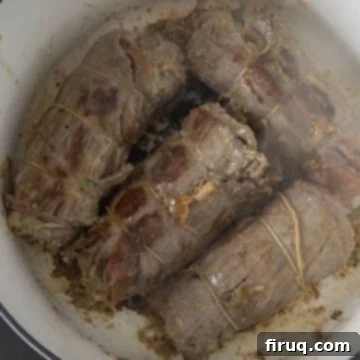
Step 7: Achieve a Quick, Even Sear. Sear each side of the braciole for approximately 60-90 seconds until a deep golden-brown crust forms. This should be a quick, high-heat sear – the goal is color and flavor, not to cook the meat through. Once all sides are beautifully seared, carefully remove the braciole from the pot and set them aside on a plate. The fond (browned bits) left at the bottom of the pot is packed with flavor and will contribute immensely to your sauce.
It’s always beneficial to sear all the braciole at once if your pot allows for it without overcrowding. The more *packed* the meat is next to each other, the less steam will cause the sides of the meat to overcook or become gray. However, this method requires the pan to be exceptionally HOT to maintain the searing temperature.
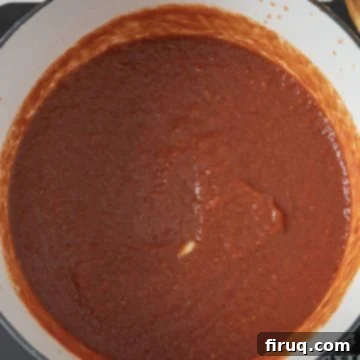
Step 8: Prepare the Braising Sauce. In the same pot used for searing, lower the heat to medium-low and add another tablespoon of olive oil if needed. Add the thinly sliced garlic and sauté for 1-2 minutes until fragrant, being careful not to burn it. Pour in the red wine and bring it to a gentle simmer, scraping up any browned bits (fond) from the bottom of the pot with a wooden spoon. Simmer for 30 seconds to allow the alcohol to cook off. Stir in the crushed tomatoes, salt, and fresh basil leaves. Bring the sauce to a gentle simmer.
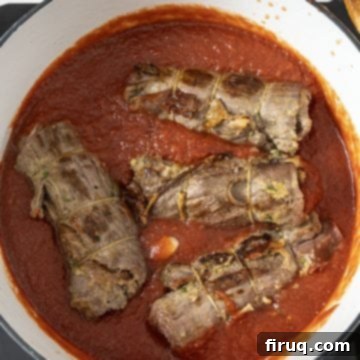
Step 9: Braise to Perfection. Gently add the seared braciole back into the simmering sauce. Arrange them so they are almost entirely covered by the sauce. If needed, add a little water or chicken broth to ensure they are adequately submerged for braising. Cover the pot with a lid, reduce the heat to low, and let the braciole simmer gently for 3 hours. Stir the sauce occasionally to prevent sticking and ensure even cooking. This long, slow braise is the secret to transforming the flank steak into incredibly tender, fork-shredding meat, while infusing the sauce with all the rich flavors of the braciole.
After 3 hours, the braciole will be wonderfully tender, and the sauce will have naturally thickened and deepened in flavor, creating a luxurious gravy that clings perfectly to pasta.
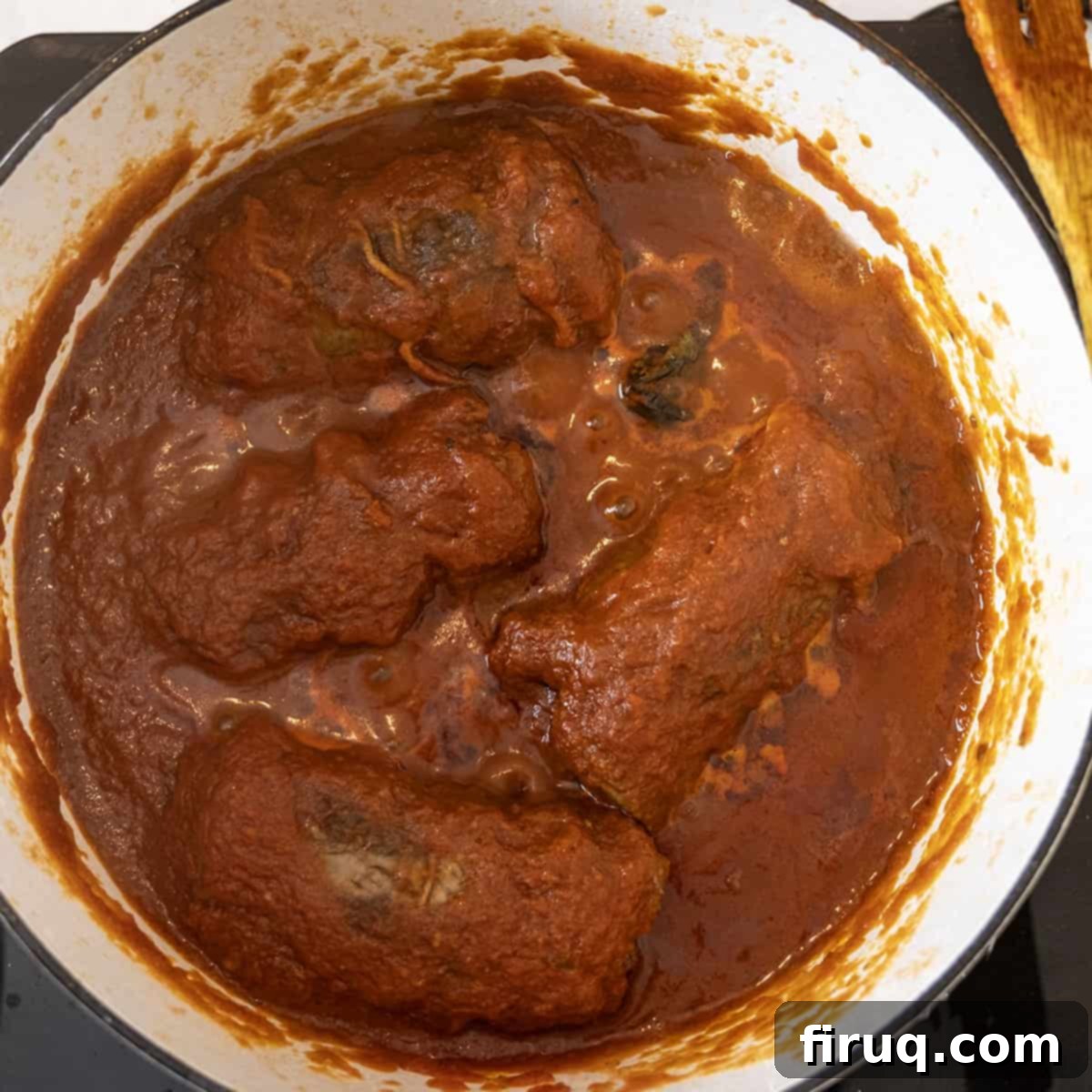
Once the braising is complete, carefully remove the braciole from the pot and use kitchen shears to cut off and discard the butcher’s string. Serve these magnificent meat rolls over your favorite pasta, generously smothered in the rich Sunday Sauce, and topped with an extra dusting of Parmesan cheese for the ultimate Italian comfort food experience!
Pro-Tips for the Best Authentic Italian Braciole
Achieving a truly exceptional braciole involves a few insider tricks. Here are some pro-tips to ensure your dish is nothing short of perfect:
- Master the Sear: The initial sear is paramount for flavor. You want your pot to be very hot when you place the braciole in. I highly recommend using a heavy-bottomed Dutch oven for this step, as they distribute heat incredibly evenly and retain it well, leading to a superior crust. Move quickly when turning the braciole to ensure all sides get a good sear without overcooking. After searing, if there are just some delicious brown bits (fond) stuck to the bottom of the pot, don’t worry – these will deglaze and add incredible flavor to your sauce. However, if the bottom is severely burnt, it’s best to clean it out before making the sauce to avoid a bitter taste.
- Precision Slicing and Tenderizing: The thickness of your flank steak is crucial. When slicing, think of it like you’re preparing thinly sliced chicken cutlets. Use a very sharp knife to achieve consistent, thin pieces (around ¼-inch thick). If you’re struggling, butterfly the steak first, then cut it into thinner sections. After slicing, tenderize the meat thoroughly with a mallet. This not only makes the meat more pliable for rolling but also ensures it becomes incredibly tender during the long braising process, preventing a chewy texture.
- Secure Rolling is Key: To keep your flavorful filling securely inside the braciole and prevent it from unraveling during the long braise, always use butcher’s string. While toothpicks might seem convenient, they don’t provide the same tight hold as string, which can lead to a messy interior and less evenly cooked meat. Tightly wrapping the braciole with string ensures the filling stays put, contributes to a better shape, and results in much more tender, cohesive meat bundles at the end.
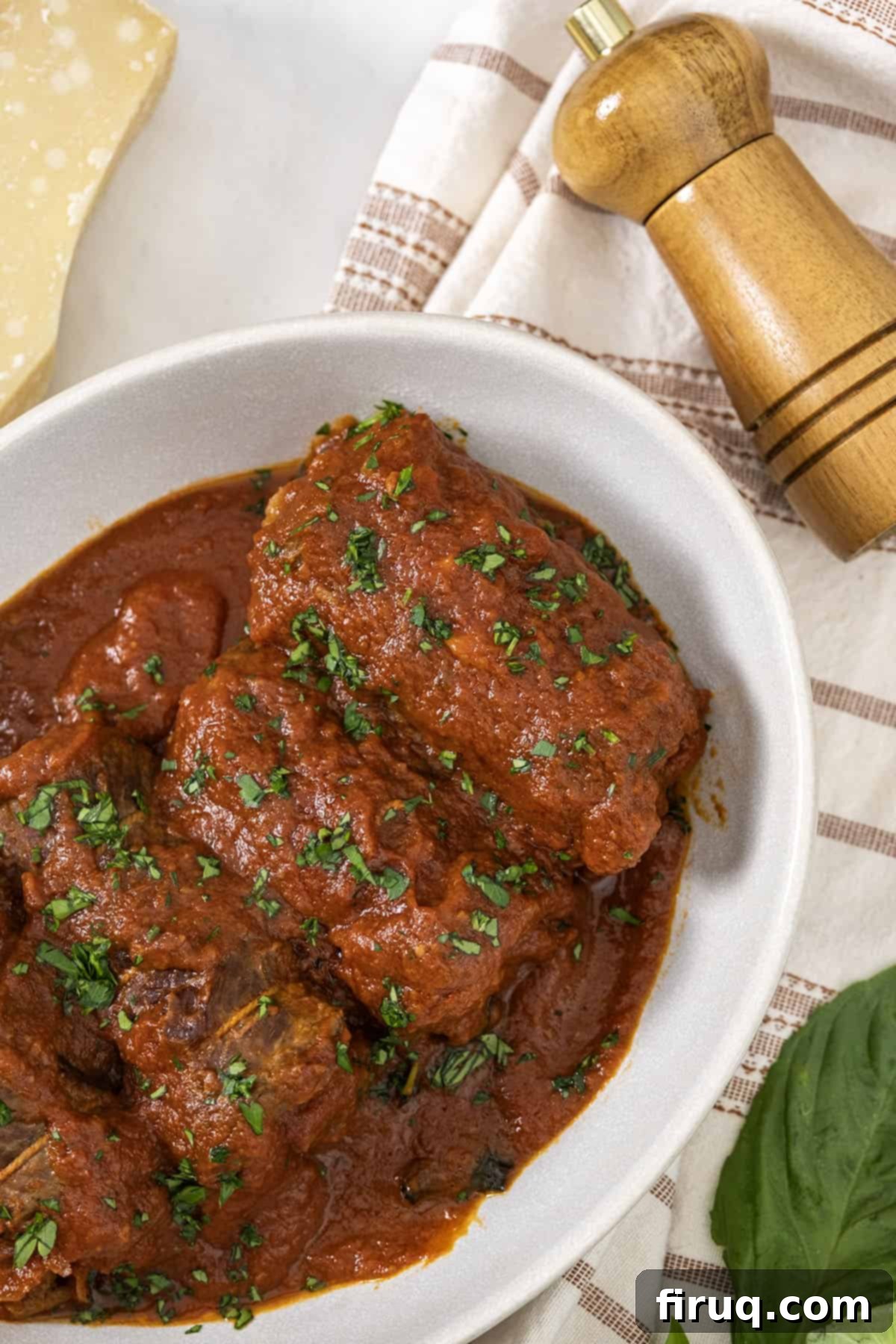
What to Serve with Your Perfect Braciole
Braciole is a hearty and flavorful dish, perfect as the star of a traditional Italian-American Sunday dinner. Here are some complementary dishes to create a truly memorable meal:
- The Full Sunday Sauce Experience: I always recommend serving braciole alongside classic sausage and our fried Italian meatballs, all simmering together in our beloved Sunday sauce. This trifecta of meats is especially perfect when you’re feeding a large family or entertaining guests. For an extra touch of homemade goodness, you can even learn how to make your own sausage by following our How to Make Homemade Italian Sausage guide!
- Pasta Perfection: With a thick, rich sauce like the one braciole creates, selecting the right pasta is key. I personally prefer sturdy shapes like rigatoni, paccheri, or ziti, as they are excellent at catching and holding onto the robust sauce. However, rotini or even classic spaghetti will also be delightful, ensuring every strand is coated in savory goodness.
- Balancing Vegetable Sides: To complement the richness of the meat and sauce, some fresh vegetable sides are essential. A crisp Caesar salad offers a bright contrast, or for something with more substance, try hearty Italian cabbage or nutrient-rich Lacinato kale, simply sautéed with garlic and olive oil.
- Appetizers to Start the Feast: If you’re hosting a grand Italian dinner and want to offer appetizers before the main course, consider heartier options like Pepperoni Bread (Stromboli) or Italian Sausage Bread. For a lighter start, a quick and elegant Shrimp cocktail or some flavorful marinated eggplant can set the stage beautifully.
Recipe FAQs: Your Braciole Questions Answered
Braciole can be made from various cuts of meat, most commonly beef, veal, or pork. The specific cut often depends on regional traditions and personal preference. Flank steak, top round, or sirloin are popular beef choices, while thinly sliced veal or pork cutlets are also used, especially for quicker cooking times.
Braciole has deep roots in Southern Italian cuisine, where it originated as a dish of thinly sliced meat roasted over hot coals, literally meaning “on the embers.” However, the stuffed and braised version we commonly recognize today, especially in rich tomato sauce, is largely a product of Italian-American culinary tradition. In Italy, a stuffed meat roll braised in sauce is more broadly referred to as “involtini.” So, while the concept is distinctly Italian, the specific “braciole” as an Italian-American Sunday classic has evolved considerably from its original Italian namesake.
Absolutely! Braciole is an excellent make-ahead dish. In fact, many believe the flavors deepen and meld even more wonderfully the day after it’s cooked. You can prepare and braise the braciole entirely, then let it cool, cover it, and refrigerate it for up to 3-4 days. Reheat gently on the stovetop over low heat until warmed through, adding a splash of water or broth if the sauce has thickened too much.
Yes, braciole freezes beautifully! Once completely cooked and cooled, transfer the braciole and its sauce to airtight, freezer-safe containers or heavy-duty freezer bags. It can be frozen for up to 3 months. To serve, thaw overnight in the refrigerator and then reheat on the stovetop or in the oven until piping hot.
More Classic Italian-American Recipes to Love
If you enjoyed making this authentic Italian braciole, you’ll surely love exploring more of our traditional Italian-American recipes that bring the taste of Sunday dinner to your home:
- Authentic Italian Baked Ziti
- Better Than Olive Garden Eggplant Parmigiana
- Italian Wedding Soup
- Shrimp Fra Diavolo with Linguine
Please leave a comment and star rating below in the recipe card! We love to hear what you think of our recipes and how they turn out in your kitchen. Feel free to tag us on Instagram @vindelgiudice to share your culinary creations!
📖 Recipe
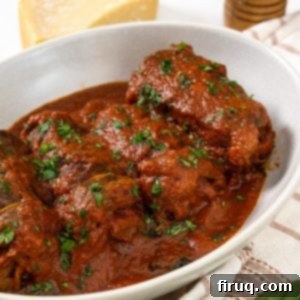
Authentic Italian Braciole
By Vincent DelGiudice
A delicious and tender beef braciole, filled with savory prosciutto, aromatic breadcrumbs, and rich Parmesan cheese. This stuffed flank steak is seared and then slowly braised in a flavorful homemade tomato sauce until it’s incredibly tender and the meat falls apart with a fork. It’s the perfect centerpiece for any Italian-American Sunday dinner.
Pin Recipe
- Prep Time:
- 30 mins
- Cook Time:
- 3 hrs
- Total Time:
- 3 hrs 30 mins
- Course:
- Main Course
- Cuisine:
- American, Italian
- Servings:
- 6 servings
- Calories:
- 587 kcal
Equipment
- 1 large pot (preferably a Dutch oven)
- Butcher’s string
- Sharp knife
- Meat tenderizer (optional but recommended)
Ingredients
For the Braciole:
- 1 (2-3 lb) flank steak
- 6 oz prosciutto, thinly sliced
- ¾ cup breadcrumbs (plain or Italian style)
- ½ cup grated Parmesan cheese
- 1 tbsp chopped fresh parsley
- 1 tbsp garlic powder
- ½ tsp salt
- ¼ cup olive oil (for breadcrumb mixture)
- Salt and pepper to taste (for seasoning steak)
For the Sauce:
- 2 cloves garlic, thinly sliced
- ½ cup dry red wine (e.g., Chianti, Merlot)
- 1 (28 oz) can crushed tomatoes (preferably San Marzano)
- 4 fresh basil leaves
- 1 tsp salt
- 1 tbsp olive oil (for sauce base)
Instructions
- Prepare the Filling: In a medium bowl, combine the breadcrumbs, parsley, Parmesan, salt, and garlic powder. Add ¼ cup olive oil and mix until the texture is clumpy but not wet. Adjust olive oil as needed.
- Prepare and Stuff the Steak: Thinly slice the flank steak with a sharp knife into 2 or 3 pieces, depending on thickness. Lay each steak flat, cover with plastic wrap, and use a meat tenderizer to flatten and tenderize. Lay prosciutto slices over each steak, then spread the breadcrumb mixture evenly.
- Roll and Sear: Roll each stuffed steak tightly and tie securely with butcher’s string. Season the outside with salt and pepper. In a large, heavy-bottomed pot or Dutch oven, heat 1 tablespoon olive oil over medium-high heat until very hot. Sear the braciole on all sides for 60-90 seconds per side until golden brown. This should be a quick sear; do not overcrowd the pot. Set the seared braciole aside.
- Make the Sauce and Braise: In the same pot, reduce heat to medium-low. Add another tablespoon of olive oil if needed. Add sliced garlic and sauté for 1-2 minutes until fragrant. Pour in the red wine, bring to a simmer, and simmer for 30 seconds, scraping up any fond. Add crushed tomatoes, basil leaves, and 1 tsp salt. Bring to a simmer.
- Slow Cook: Return the seared braciole to the sauce, ensuring they are almost completely covered. Cover the pot and simmer on low heat for 3 hours, stirring occasionally to prevent sticking and ensure even cooking. The sauce will thicken, and the meat will become incredibly tender.
- Serve: Carefully remove the braciole from the sauce. Using kitchen shears, cut off and discard the butcher’s string. Serve the braciole hot over your favorite pasta, generously smothered with the rich tomato sauce and an extra sprinkle of Parmesan cheese. Enjoy!
Notes
- For the best sear, ensure your pot is very hot. A Dutch oven is ideal for even heat distribution. If the bottom of your pot is burnt after searing, clean it before starting the sauce to avoid bitterness. Otherwise, the browned bits will add flavor.
- Slice flank steak thinly and uniformly, similar to chicken cutlets, for consistent tenderness. A very sharp knife is essential for this.
- Always use butcher’s string, not toothpicks, to secure the braciole. String provides a tighter wrap, which helps keep the filling intact and results in more tender meat.
Nutrition Facts (per serving)
- Calories:
- 587 kcal
- Carbohydrates:
- 12g
- Protein:
- 49g
- Fat:
- 35g
- Saturated Fat:
- 11g
- Polyunsaturated Fat:
- 4g
- Monounsaturated Fat:
- 18g
- Trans Fat:
- 0.04g
- Cholesterol:
- 138mg
- Sodium:
- 1104mg
- Potassium:
- 785mg
- Fiber:
- 1g
- Sugar:
- 1g
- Vitamin A:
- 147IU
- Vitamin C:
- 1mg
- Calcium:
- 171mg
- Iron:
- 4mg
Nutrition information is an estimate and will vary based on exact ingredients and portion sizes.
Tried this recipe?
We’d love for you to Leave a Review!
